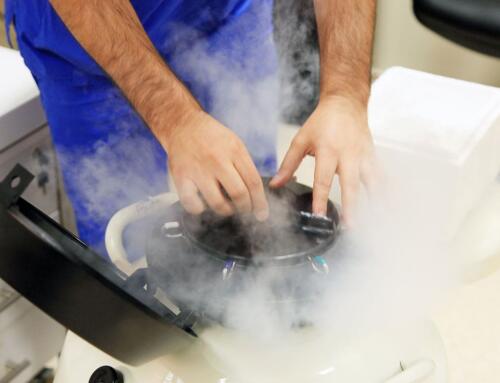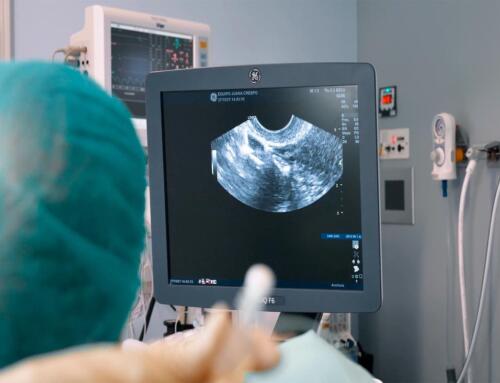Fertility problems are not exclusive to women: the male factor is directly involved in 47% of cases of sterility (inability to conceive) and in 30% of cases of infertility (difficulty in having children).
The main causes of male infertility are hormonal, genetic and vascular disorders, some infectious processes and immunological factors, although there is a percentage of cases (15%) in which the origin of infertility is unknown.
When a couple visits our assisted reproduction clinic in Valencia, one of the first steps is to conduct an initial interview and some tests. One of them is the semen analysis, simple, minimally invasive and that gives us a lot of information about the fertility of the male, having the results of the test the same day of its collection.
What is a semen analysis?
The semen analysis (or spermiogram) is the most reliable diagnostic method to evaluate male fertility.
This test consists of analyzing a semen sample in the laboratory to evaluate macroscopic (volume, color, viscosity, etc.) and microscopic (sperm concentration, sperm morphology or motility) aspects.
In what cases is a semen analysis performed? What is it used for?
Explaining the purpose of the semen analysis is quite simple: its main use is to evaluate the reproductive capacity of the male and to determine fertility problems in couples who have trouble conceiving.
In clinics such as Equipo Juana Crespo, the results of the semen analysis are essential to choose the most appropriate fertility treatment or assisted reproduction technique: if they are normal, scheduled intercourse or artificial insemination can be used, while if the semen shows any pathology that compromises the fertility of the man, in vitro fertilization will be chosen.
On the other hand, the semen analysis is a useful tool for detecting certain pathologies which, in addition to making pregnancy difficult, can cause health problems for the man or for his reproductive system. The reason is that hormonal alterations such as hypogonadism, hyperprolactinemia, hyperthyroidism, hypothyroidism or diabetes can affect sperm development, and this test helps to confirm their presence.
Finally, the semen analysis is valid and reliable to check the efficacy of some surgical interventions such as vasectomy (section and ligation of the vas deferens) or varicocele surgery.
How is a semen analysis performed?
Now that we have explained what the semen analysis is and what it is used for, we will go into more detail on how this test is performed, paying attention to two fundamental aspects: obtaining the sample and its analysis in the laboratory.
-
Obtaining the sample
The World Health Organization, in its document “Manual for the examination of human semen and semen-mucus interaction”, establishes a series of parameters to guarantee that the results of a semen analysis are valid.
- The semen analysis should always be performed after a period of sexual abstinence not exceeding 5 days. This period includes the absence of sexual intercourse and masturbation.
- The semen is obtained by masturbation of the patient. Previously, the patient must have washed his hands and genitals properly.
- The sample will be deposited in a sterile jar, in this case provided by our clinic. It is very important to obtain the total ejaculate, otherwise the sample will not be representative and the semen analysis will not be valid.
- Ideally, semen collection should be performed at our clinic, although it is also possible to do it at the patient’s own home, provided that no more than 30 minutes elapse between ejaculation and delivery of the sample to the laboratory.
- During this time, the sample must be kept in specific temperature and light exposure conditions: it is recommended to keep it in the pocket (in direct contact with the body) and wrap it in aluminum foil to avoid light.
2. Sample analysis
The analysis of the sample is carried out in the laboratory, establishing two types of parameters to be evaluated:
Parameters at macroscopic level:
- Liquefaction. Shortly after ejaculation, semen liquefies and becomes a more fluid liquid due to the action of a protein called fibrinolysin. When a sample does not liquefy, it means that there is an error in the production of this protein, which can alert us to the presence of some pathology.
- Color. Under normal conditions, semen has a whitish or grayish color. If a sample has a reddish color, it will indicate the presence of blood, and if it is yellowish, it may be a symptom of a possible infection. In both cases, it is necessary to consult a physician.
- Volume. The WHO establishes that the normal amount of an ejaculate should be greater than 1.4 milliliters. If it is less, the patient suffers from hypospermia (low ejaculate production) or other problems directly related to the difficulty in achieving pregnancy.
- pH. The pH is the unit of measurement that allows us to know the percentage of acid or alkaline in a liquid or solution. In the case of human semen, the WHO establishes that the pH should be greater than 7.2. A lower figure may indicate pathologies in the glands of the male reproductive system.
- Viscosity. If the semen is too viscous it can hinder the mobility of the spermatozoa and this, in turn, reduces the chances of pregnancy.
Microscopic parameters:
- Sperm concentration. The concentration of spermatozoa is a fundamental indicator for assessing male fertility, and is one of the parameters that carry the most weight when we perform a semen analysis. According to the WHO, in order to study sperm concentration, the concentration of spermatozoa per milliliter (ml), on the one hand, and the total number of spermatozoa per ejaculate, on the other hand, must be taken into account.
In the first case, the figure considered normal is 16 million/ml. In the second, 39 million/ejaculate. If the values are lower we would be talking about oligozoospermia or cryptozoospermia.
- Motility. Motility is the capacity of spermatozoa to move. To assess the total movement of a semen sample, at least 42% should have movement and 30% progressive motility (i.e., spermatozoa move and advance).
- Vitality. This parameter determines the percentage of live spermatozoa in a sample. To check it, a “staining” test is performed. A sample is considered normal when the number of live spermatozoa is equal to or greater than 54%.
- Morphology. Spermatozoa have three parts: a head, neck or midpiece and a tail. The WHO qualifies as a morphologically normal semen sample that in which there is a value equal to or greater than 4% of “ideal spermatozoa” without alterations in any of its parts.
- Presence of leukocytes or epithelial cells. Sperm may contain, in addition to spermatozoa, other types of cells, including epithelial cells (by skin sloughing) or leukocytes. However, if a semen analysis shows a high content of leukocytes, it is possible that there is an infection.
In Juana Crespo we have a urology unit specialized in male infertility and male health where we treat prostate, urinary and hormonal pathologies that may compromise male fertility.
In addition to the seminogram, we perform other tests related to the study of semen, including the Recovery of Motile Sperm (REM) test, DNA fragmentation studies and semen cultures.
If you have any questions about your reproductive capacity or about what a semen analysis is and what it is for, we will help you to solve them. Contact us and our team will be happy to talk to you.















